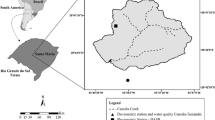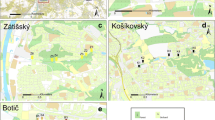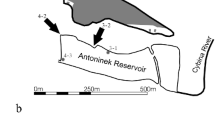Abstract
Background, aim, and scope
In urban areas, storm water runoff often transports various pollutants, some of which settle and form sediments. In order to have the comprehensive view of the ecological state of storm water runoff recipients, both water and sediments of the stream must be assessed. In the Baltic Sea Area, the Water Framework Directive & HELCOM Recommendations aim to prevent or minimise pollution caused by harmful substances arising from storm water runoff, in order to promote the ecological restoration of the Baltic Sea—one of the most vulnerable seas. The aim of the study was to investigate the toxicity of bottom sediments of a small storm water runoff recipient focusing on the potential impact of successive discharges of urban storm water. Some storm water runoff quality parameters and the toxicity of bottom sediments of recipients was studied in this research.
Materials and methods
During 9 years, at four discharge points, minimum four grab samples per year at each discharge point were taken for chemical characterisation. General parameters (pH, SS, BOD7, CODCr and TPH) in liquid phase samples were analysed according to standard methods. Annual limit values were taken from the Lithuanian EPA requirements for the management of storm water runoff with a focus on prevention and control of contamination. Eleven composite samples of stream bottom sediments, each consisting of ten sub-samples, were collected in 2006. Toxicity screening from sediments was performed using the plant Lepidium sativum according to modified I. Magone’s methodology (Magone I, Bioindication of phytotoxicity of transport emission. In: Kachalova O-L, Zinatne (eds) Bioindication of toxicity of transport emissions in the impact of highway emissions on natural environment. Riga, pp 108–116, 1989). The level of toxic impact of Lepidium sativum (compared to control) was assessed according to the modified method of Wang (Rev Environ Contam Toxicol 126:88–127, 1992).
Results
The mean pH of urban storm water runoff does not vary much from neutral, but range values are quite different, from 4.0 up to 8.7. The highest concentration of SS reached 800 mg L−1, TPH—2.4 mg L−1, BOD7—300 mg O2 L−1 and CODCr—1,400 mg L−1. The SS was above the limit in 64% of total amount of grab samples, TPH—37%, BOD7—41% and CODCr—55%. The toxicity analysis of the bottom sediments showed varying toxicity of bottom sediments along the stream. From nine analysed samples of bottom sediments, 30% had weak toxicity, 30% medium and 30% strong toxicity on the test organism plant L. sativum. There was one single sample with no toxic effects, so that the results showed that urban storm water has an unacceptable environmental impact on recipients. It was also indicated that storm water runoff discharge alone is not the potential source of toxicity of bottom sediments. The litter demonstrated a weak toxicity of bottom sediments as well.
Discussion
Most local authorities do not consider storm water runoff discharges to be a matter of great concern because they believe that surface runoff arising from rainfall is still relatively clean. The study showed that the current method of monitoring storm water runoff quality by chemical analyses is not the best tool for environmental impact assessment and must be combined with toxicity tests of bottom sediments of recipients.
Recommendations and perspectives
To avoid the environmental impact of storm water runoff more attention should be paid to the development and implementation of storm water runoff pollution prevention measures. The study implies that future research concerning the relationships between storm water runoff deposit characteristics and biological activities must be developed to evaluate the contamination potential of stream sediment deposits for local aquatic ecosystems. Further studies should be developed to characterise the activities of the microbial community of storm water runoff sediments, and to monitor bioremediation in situ.



Similar content being viewed by others
References
Christensen A-M, Nakajima F, Baun A (2006) Toxicity of water and sediments in a small urban river (Store Vejleå, Denmark). Environ Pollut 144:621–625
Davis A-P, McCuen R-H (2005) Stormwater Management for Smart Growth. Springer Science + Business Media, ISBN 9780387260488, pp 133
Davis A-P, Shokouhian M, Ni S-B (2001) Loading estimates of lead, copper, cadmium, and zinc in urban runoff from specific sources. Chemosphere 44(5):997–1009
Ellis JB (2000) Risk assessment approaches for ecosystem responses to transient pollution events in urban receiving waters. Chemosphere 41:85–91
EN 1899–1 (1998) Water quality—Determination of biochemical oxygen demand after n days (BODn)—Part 1: Dilution and seeding method with allylthiourea addition (ISO 5815:1989, modified)
EN 872 (1996) Water quality—Determination of suspended solids—Method by filtration through glass fibre filters
EPA 833–8–92–001 (1992) NPDES Storm Water Sampling Guidance Document
Eriksson E, Baun A, Mikkelsen P-S, Ledin A (2005) Chemical hazard identification and assessment tool for evaluation of stormwater priority pollutants. Water Sci Technol 51:47–55
European Commission (2003) Technical guidance document on risk assessment. Part II. European Commission, Brussels
German J, Svensson G (2002) Metal content and particle size distribution of street sediments and street sweeping waste. Water Sci Technol 46(6–7):191–198
Hatch A-C, Burton G-A (1999) Sediment toxicity and stormwater runoff in a contaminated receiving system: consideration of different bioassays in the laboratory and field. Chemosphere 39:1001–10017
HELCOM Recommendation 23/5 (2002) Reduction of Discharges from Urban areas by the Proper Management of Storm Water Systems
Hwang H-M, Foster G-D (2006) Characterization of polycyclic aromatic hydrocarbons in urban stormwater tunoff flowing into the tidal Anacostia River, Washington, DC, USA. Environ Pollut 140:416–426
Idzelis R-L, Greičiūtė K, Paliulis D (2006) Investigation and evaluation of surface water pollution with heavy metals and oil products in Kairiai military ground territory. J Environ Eng Landsc Manag XIV(4):183–190
ISO 5667–1 (2006) Water quality—Sampling—Part 1: Guidance on the design of sampling programmes and sampling techniques
ISO 5667–3 (2003) Water quality—Sampling—Part 3: Guidance on the preservation and handling of water samples
ISO 6060 (1989) Water quality. Determination of the chemical oxygen demand (ISO 6060:1989)
ISO 9377–2 (2000) Water quality-Determination of hydrocarbon oil index—Part 2: Method using solvent extraction and gas chromatography
ISO/IEC 17025 (2005) General requirements for the competence of testing and calibration laboratories
Lau S-L, Stenstrom M-K (2005) Metals and PAHs adsorbed to street particles. Water Res 39:4083–4092
Lithuanian EPA (2003) Environmental requirements for the management of storm water runoff: pollution prevention, collection, treatment and discharge. (in Lithuanian: Aplinkosaugos reikalavimai paviršinėms nuotekoms tvarkyti. No. 687)
Magone I (1989) Bioindication of phytotoxicity of transport emission. In: Kachalova O-L, Zinatne (eds) Bioindication of toxicity of transport emissions in the impact of highway emissions on natural environment. Riga, pp 108–116
Makepeace D-K, Smith D-W, Stanley S-J (1995) Urban stormwater quality: summary of contaminant data. Crit Rev Environ Sci Tech 25:93–139
Marčiulionienė D-E, Montvydienė D, Karlavičienė V, Hogland W (2005) Lepidium sativum L. as Test-organism for Assessment of Environmental Pollution. Proceedings of Kalmar ECO-TECH’05 and The Second Baltic Symposium on Environmental Chemistry, Sweden, November 28–29
Marsalek J, Rochfort Q, Mayer T, Servos M, Dutka B, Brownlee B (1999) Toxicity testing for controlling urban wet-weather pollution: advantages and limitations. Urban Water 1:91–103
Neto M, Ohannessian A, Delolme C, Bedell J-P (2007) Towards an optimized protocol for measuring global dehydrogenase activity in storm-water sediments. J Soils Sediments 7(2):101–110
Novotny V, Barnwell T, Donigian A, Huber W, Olem H, Roesner L, Salomons W, Shanahan P, Somlyody L, Stol B (1995) Nonpoint pollution and urban stormwater management. Technomic Publishing, Lancaster
Ohio EPA (2001) Division of Surface Water. Sediment Sampling Guide and Methodologies. 2nd ed, p 36
Robson M, Spence K, Beech L (2006) Stream quality in a small urbanised catchment. Science Total Environ 357:194–207
Viklander M (1998) Particle size distribution and metal content in street sediments. J Environ Eng 124:761–766
Wang W (1992) Use of plants for the assessment of environmental contaminants. Rev Environ Contam Toxicol 126:88–127
Wolf L, Klinger J, Hoetzl H, Mohrlok (2007) Quantifying mass fluxes from urban drainage system to the urban soil-aquifer system. J Soils Sediments 2:85–95
Acknowledgement
We would like to thank our municipal partner Grinda AB (Lithuania), industrial partner Läckeby Water Group (Sweden), Knowledge Foundation (Sweden) and Granninge Foundation (Sweden).
Author information
Authors and Affiliations
Corresponding author
Additional information
Responsible editor: Stefan Norra
Rights and permissions
About this article
Cite this article
Karlavičienė, V., Švedienė, S., Marčiulionienė, D.E. et al. The impact of storm water runoff on a small urban stream. J Soils Sediments 9, 6–12 (2009). https://doi.org/10.1007/s11368-008-0038-9
Received:
Accepted:
Published:
Issue Date:
DOI: https://doi.org/10.1007/s11368-008-0038-9




